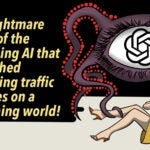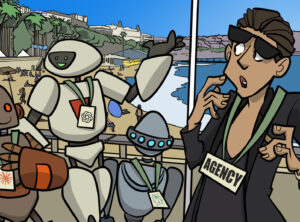This article is based on interviews conducted with early DoubleClick employees and a co-founder. It was written by an external contributor who prefers not to be identified.
Suddenly, last summer, Google announced it was erasing the DoubleClick name from its product portfolio. So ends 23 years of ad tech myth and legend that coincides with the ad-supported internet itself.
DoubleClick rode the dot-com boom to heights of overcapitalization and came crashing down with everyone else in 2000. It created New York’s Silicon Alley, had outrageous parties and heavenly bills and saw just about every future ad tech luminary pass through its cult.
The iconic sign that loomed over Broadway and 22nd Street during the days of the boom defined an era:
“DOUBLECLICK WELCOMES YOU TO SILICON ALLEY.”
It was an ad network and ad server before anyone knew what those were. It provided a sales team and infrastructure for advertisers to buy ads from multiple publishers in a single location, target them using criteria such as location or time of day, insert them into web pages automatically and get reports. It has quietly dominated ad serving since it started and thrived as a brand since being acquired by Google in 2007.
Success is obvious in reverse. But in the summer of 1995, two engineers named Kevin “KO” O’Connor and Dwight Merriman were sitting in O’Connor’s 2,500-square-foot basement in Alpharetta, Ga., looking for something to do. They had cashed out a networking startup in Ohio and moved south to raise families.
Kevin O’Connor, co-founder: Dwight and I came up with hundreds of ideas and narrowed them down. The original concept was a network of publications, like a cable subscription model. Then Dwight looked at how media monetizes and said advertising could be bigger. We flipped the idea into a network of advertisers.
David Gwozdz, sales director: Kevin called me and said, “I understand you’re a good ad sales guy.” I went over to his house to tell him no thanks – and ended up taking the job. Kevin met my wife, and the first thing he said was, “I’m going to make your life hell.” We worked seven days a week, morning to night.
O’Connor: Dwight was coding, and I was learning about advertising and direct marketing from textbooks. I was going to the library reading Ad Age and Adweek to see if we had any competitors.
Gwozdz: At that time, the ad server was an ISDN line and a 486 PC on Dwight’s desk with the cover off, because it kept overheating.
O’Connor: I read in an article that an agency called Poppe Tyson was doing the same thing. I thought, “Holy crap!” and called a guy there named Dave Carlick.
David Carlick, EVP, Poppe Tyson: Our interactive group was called DoubleClick. The name was invented by [Poppe Tyson CEO] Fergus O’Daly. It wasn’t a good name. It’s an old Apple term. A click on a URL is a single click, not a double click.
O’Connor: It turned out they didn’t have any tech yet. It was the classic, “Let’s launch an idea and see how the market reacts.” We were just completing the product, and they had a team of four selling ads. We decided we should work together.
Carlick: There was a long discussion about whether it should be based in New York or Silicon Valley. We decided on New York and started the whole Silicon Alley thing. The story is that when Kevin and his wife saw the tiny apartment they would have to live in, they cried.
After a tentative start, the company started to, um, click but banged into sales teams from websites like Netscape and Excite, which were Poppe Tyson’s major clients. So Fergus O’Daly decided to spin off DoubleClick into a separate subsidiary with Kevin O’Connor as CEO.
O’Connor: We were 50% owned by an ad agency. No one liked that. We tried to sell the company to someone else. There was a deal with Yahoo back in 1996 – we wanted $100 million and they offered $95 million. They wouldn’t budge.
Kevin Ryan, CFO (later CEO): I was thinking about starting an ad network, so I met with Kevin and Dwight. I thought they were very good – they had a six-month head start. So I became employee No. 12. We grew very quickly. Four years later, we had 2,000 employees in 25 countries.
Gwozdz: I was still in Atlanta, in a little office usually by myself. I remember I went to a sales meeting in Colorado Springs, and there were 200 people in the room. I didn’t understand how big this was getting.
O’Connor: Everything started to go through the roof – a lot of revenue, with hefty margins. We needed capital. The mantra was “get big fast.”
Gwozdz: We started picking up pub after pub. We were an upstart with really good tech no one else had. We could target by location, time of day, exclusion. People would light up. They loved the reporting.
Bill Wise, director, financial planning (later VP/GM): KO would get up in these meetings and he was so aggressive – we loved it. He said, “We are the company that is changing advertising and media. We won’t stop until we have world domination.” It wasn’t a job, it was a cult – a feel-good cult.
DoubleClick went public in 1998 on the Nasdaq exchange under the ticker symbol DCLK. It was the beginning of the bubble’s last bleat. The Nasdaq rose 86% in 1999. It soared 5x from 1,000 to 5,000 in the five years before 2000. There were 15-20 dot-com parties every week in San Francisco. About 70% of digital ad dollars came from VC-funded dot-coms. Of course, few people suspected what was coming. They were just trying to find a place to sit.
Wise: There was a temp who was working under [VP of sales] Wenda Millard – a great kid – he was sitting in the hallway. One day somebody put a “Kids in the Hall” poster up behind his desk and crossed out the “s.” He was known as the “Kid in the Hall.”
Brad Bender, director of product management (later VP): They put me where they’d moved a copier out. It was the world’s smallest desk. I was the “Kid in the Hall.” The executive team was right around the corner from me. I remember Kevin O’Connor came by with clients and said, “Look, we’re growing so fast, we even have a ‘Kid in the Hall.’”
Wise: Eventually we maxed out the space and threatened Manhattan that we were going to move to Jersey City. They ended up giving us tons of tax credits to keep us, since we were the founders of Silicon Alley. We built out the space on 33rd Street and 10th Avenue.
Scott Knoll, director of business development (later VP/GM): 33rd Street was a brand-new building. It had a climbing wall, a multimillion-dollar basketball court. We had to build a special platform to muffle the noise for the tenant under us. It was spectacular. There was a view of the Hudson River. Bleachers. Fiberglass backboards, a scoreboard and lighting.
Wise: DoubleClick had the best parties. KO was at sales conferences playing guts and taking stock options as currency.
Ryan: We went all-out at Halloween. Everyone came to the office in costume. One year I showed up as a mummy. I had trouble getting a taxi and I couldn’t get into the building. I had to remind the manager that he knew me. Then 200 of us marched up Fifth Avenue at 10 a.m. in our costumes.
Then the company got a real scare. It decided to merge with Abacus in 1999 for $1.7 billion. Abacus was a consumer data co-op that tracked the catalog buying habits of most US households. Trouble was, it used personally identifiable information, which DoubleClick proposed to map to its (anonymous) cookies.
O’Connor: Abacus was a great company that had a tremendous amount of offline purchase data. That acquisition was about ways to combine offline and online consumer purchase data. We weren’t wrong about it. But we came up against privacy concerns.
Wise: USA Today published a story that DoubleClick was going to try to marry online and offline data. It got picked up by other publications and got a lot of attention.
Knoll: Abacus was frustrating. It was a situation where the influence of media was major but they didn’t have the story right. Nothing had actually been done yet.
Wise: KO took the fall, as a great leader does. He cared more about the company than his own legacy. It was sad how it went down.
O’Connor: I can’t say Abacus was overblown. It is what it is. People were afraid. I left [in July 2000] because I couldn’t see a path to where I could enjoy my job. I’m a product guy and an engineer. I like building things. I was a reluctant CEO. In the end my job was just dealing with politicians, the media and lawyers. I wasn’t good at it. I was burned out. Fortunately, Kevin Ryan loved dealing with those folks, so he stepped up from president to CEO.
What went up came down. In the 30 months after the market peaked on March 10, 2000, the Nasdaq fell 78%. Between 2000 and 2001, the Super Bowl went from airing 16 dot-com spots to three, two of which were job-hunting sites. By one account, CPMs for banner ads fell from $50 to $5. More people were leaving the Bay Area in panic than arriving with hope in their hearts.
Ryan: Most of our publisher clients went bankrupt. It was Pets.com times 100. Those were our clients. We did seven rounds of layoffs and went from 2,000 to 1,000 people. We turned over the entire management team. A lot of them couldn’t do the sixth round and still feel good about it.
Bender: It was a challenging time. It wasn’t clear when we were going to be done with the cuts. A lot of people I valued as colleagues and friends weren’t around after that period. But it was a healthy retrenchment.
Ryan: We lost 30% of revenue but eliminated 50% of cost. So by 2004-05, we were actually profitable.
Ari Paparo, VP, rich media: When I joined [in 2004], there was no structured onboarding. My boss quit on my third day. The layoffs were done, but it was just a crappy company. It was dysfunctional, engineering products that were incredibly bad.
Ryan: In 2005, our valuation was very low, just like everyone. The board felt we were undervalued, so they hired Lazard and interviewed 50 buyers.
Paparo: The company announced publicly it was going to look at strategic alternatives nine or 10 months before [SF-based private equity firm] Hellman & Friedman closed. Even Google bid a fraction of what they later paid.
O’Connor: Google’s perception was that we were a sales company. They thought tech could only be built in Silicon Valley. They were wrong – as they realized later.
Ryan: DoubleClick sold at a 50% premium to the stock price. Kevin and Dwight and I didn’t think that was a good price. We thought the board might be wrong. They didn’t know that the ad volumes had already turned up.
Paparo: David Rosenblatt became CEO. He quickly made some hard decisions. He sold off the mail division, closed Abacus in Europe and sold Abacus, sold marketing automation. The product team was a lean mean machine. There was accountability and process.
Bender: Hellman & Friedman came in and clarified the lines for each of the component parts. They focused on the ad tech use case. They were clear.
Gone was the 33rd Street pleasure palace, aka “Click City,” replaced by a less lavish space on Eighth Avenue. Abacus was sold to Epsilon. DoubleClick was shopped and Google jumped. Its expansion from search into display was not beloved by all. Microsoft objected before the Senate Subcommittee on Antitrust that “this acquisition would give a single firm exclusive control over the largest database of information on individual online behavior the world has ever known.”
But the deal closed in April 2007, with Google paying $3.1 billion in cash. By any measure, it was a very smart move, expanding Google’s power in programmatic advertising. It also domesticated the demon.
Paparo: DoubleClick was on the eighth floor of the Eighth Avenue location, and Google was coincidentally in the same building on the fourth floor. When the acquisition happened, the first thing they did was wheel in truckloads of snacks. That was their first impact.
Bender: Google operates like a small company, even though it isn’t a small company.
Paparo: Everything changed under Google. It had a big impact on the company’s culture. It was more engineering-driven but more whimsical. Less business-oriented. Google cut a quarter to a third of the jobs, and they were unwilling to allow legacy tech to survive.
Bender: I brought a couple ideas to strategic planning to fund, including yield management and the ad exchange. The exchange was ultimately brought to fruition by Scott Spencer and Michael Rubenstein and became AdX.
Paparo: There were no crazy parties. No shenanigans. People had kids. The expense accounts were not like they were before the crash. But our class made a lot more money. The early guys had more fun, but they ended up with stock that was worthless.
O’Connor: It is viewed as one of the most successful M&A deals ever. I’m happy it lasted so long and continues today under the Google brand.
Bender: It’s bittersweet for me to say goodbye to the DoubleClick name after 20 years. But it delivered on the mission of becoming the operating system for advertising.













